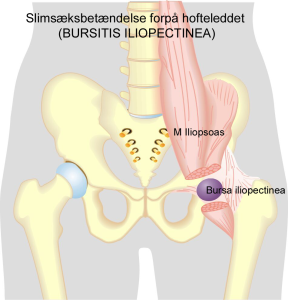Anatomy

Between the deep hip flexor (M iliopsoas) and the joint capsule is a bursa (bursa iliopectinea), which has the function of reducing the strain on the muscle as it slides over the hip joint. The bursa often communicates with the hip joint.
Cause
When the bursa at the front of the hip fills with fluid and causes symptoms, it is usually due to changes in the hip joint. An enlarged bursa at the front of the hip is thus primarily a sign of an injury in the hip joint. However, irritation of the bursa can also be caused by mechanical irritation of the iliopsoas over the hip joint.
Symptoms
Pain from pressure on the bursa at the front of the hip joint. There is usually no radiating pain. The pain is often aggravated by activation of the deep hip flexor and flexion in the hip joint.
Examination
Treatment primarily involves relief from pain-inducing activity, stretching and graduated rehabilitation within the pain threshold. Treatment can be supplemented with anti-inflammatory drugs (NSAIDs) or injection of adrenal cortex hormone into the bursa, preceded by ultrasound-guided drainage of the bursa.
Treatment
Treatment primarily involves relief from pain-inducing activity, stretching and graduated rehabilitation within the pain threshold. Treatment can be supplemented with anti-inflammatory drugs (NSAIDs) or injection of adrenal cortex hormone into the bursa, preceded by ultrasound-guided drainage of the bursa.
Of course, it’s important to treat the triggering cause, which is often found in the hip joint, to avoid relapse.
Complications
If progress is not smooth, consider whether the diagnosis is correct or if complications have arisen
In particular, the following should be considered:
- Degenerative arthritis
- Hip joint lobe (Labrum)
- Brupture of the superficial hip flexor
- Rupture of the deep hip flexor
- Inner snapping hip
- Fluid accumulation in the joint
- Fatigue fracture of the femoral neck
- Inguinal hernia
- Inflammation of the adductor of the thigh
- Inflammation of the pubic joint
- Nerve entrapment
